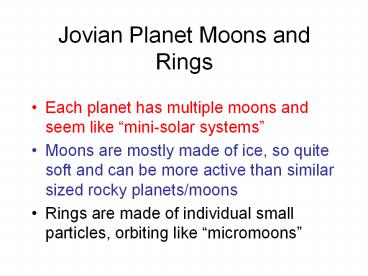Jovian Planet Moons and Rings PowerPoint PPT Presentation
Title: Jovian Planet Moons and Rings
1
Jovian Planet Moons and Rings
- Each planet has multiple moons and seem like
mini-solar systems - Moons are mostly made of ice, so quite soft and
can be more active than similar sized rocky
planets/moons - Rings are made of individual small particles,
orbiting like micromoons
2
A Mini-Solar System
- Many moons, 4 big ones found by Galileo, another
12 over 350 years from the Earth - Dozens more by spacecraft imaging on
fly-bys/orbits most are captured asteroids - Jupiter also has a narrow, faint ring system
3
JUPITER The Galilean Moons
- Io and Europa -- smaller, rockier, differentiated
- Ganymede and Callisto -- further, bigger and
icier Ganymede is the biggest Moon in SS
4
Jupiter Surrounded by Moons
- Named after lovers of Jupiter from mythology
Galilean all have synchronous orbits - Almathea inside them (181,000 km from center
260 km diameter) -- discovered in 1892 by Barnard - 4 even smaller moons found inside Galilean (found
by Voyagers and early Galileo) - 4 moons around 11,000,000 km out e and i high
captured asteroid(s) known from Earth - 4 more captured moons around 23,000,000 km out
these have retrograde orbits. - A total of 63 known in 2009 -- largest number of
confirmed moons
5
IO most active object in SS
- a 422,000 km D 3640 km M 1.22 MMoon
- Multicolored surface yellow, orange, red, brown,
and white sulfur S compounds - Rocky mantle Fe/FeS core ? 3.5 g/cm3
- Strong tidal flexures P 1.77d 1/2 P(Europa)
1/4 P(Ganymede) ? forced heating from resonant
orbit - Sulfur volcanoes blasting out particles Very
smooth, young ( lt 1 Myr) surfaceflows Fills up
Jupiter's plasma torus ionized S atoms.
6
Io and its Volcanoes
7
EUROPA Icy Oceanic?
- a 671,000 km D 3130 km M
0.65 Mmoon ? 3.04 g/cm3 - Icy crust kms thick, temporary cracks Colored
areas mostly mineral rich ices Probable 100 km
thick ocean -- LIFE EXISTS(ED) THERE ???? - Surface lt 100 Myr old new ice replacing old
- Less heating by tidal flexure than Io, but still
a good bit warmed up from resonant orbits
8
Europa cracked, oozy ice
Liquid water ?on surface?
9
GANYMEDE King of the Moons
- a 1,070,000 km D 5270 km
- M 2.02 MMoon
- ? 1.93 g/cm3 ? very thick ice layer
- Rocky mantle, Fe/FeS core Many craters, many
old ones survive Grooved terrain ? plate
tectonics at 3 Gy in the past - Only satellite with a magnetic field
10
Ganymede
11
CALLISTO Deadest of All Biggies
- a 1,880,000 km D 4800 km M 1.46
Mmoon ? 1.83 g/cm3 ? mixture
of rock and ice - More craters, fewer faults, than Ganymede

